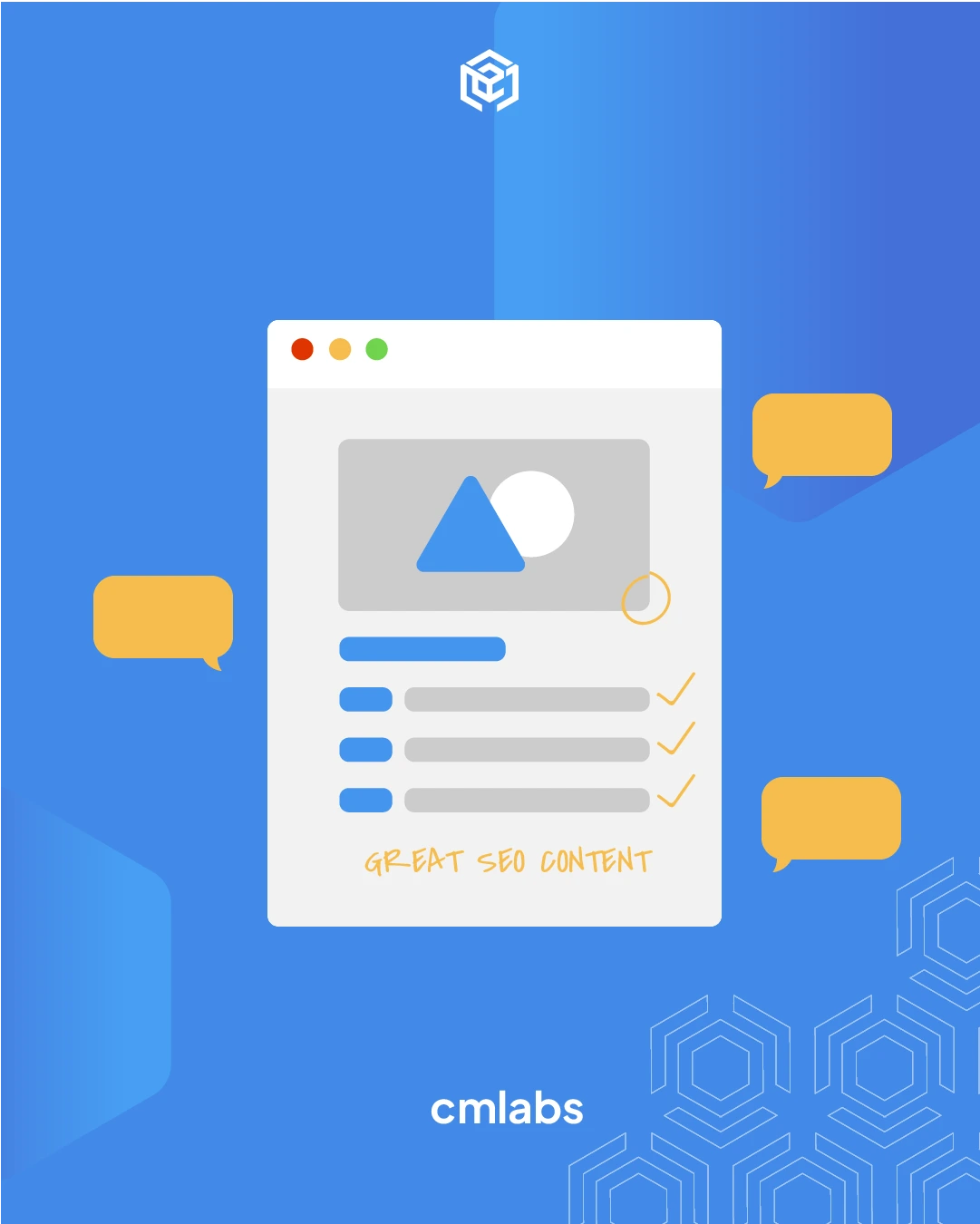We use cookies
This site uses cookies from cmlabs to deliver and enhance the quality of its services and to analyze traffic..
SEO SERVICES
Conduct in-depth technical website audits, strategically develop website projections, and increase your website authority.
ASO SERVICES
Elevate Your App’s Presence with Our Expert ASO Services – Boost Visibility and Drive Downloads!
WRITING SERVICES
We offer a variety of writing services to suit different business necessities. Reach broader audiences or lead specific industries? We've got you covered!
Get relevantly positive media exposure from bloggers and online publishers to increase your brand mentions on search engine results pages.
SEOlutions
A unified source of truth!
SEO & Digital Maternity Solution
SEO & Digital Maternity Solution: Leverage Cross-Platform Insights to Elevate Your Strategy with Expert Consultation
SEO & Digital Maternity Solution
Data Solution options:
Starting from Rp200 mio
Reinventing how a company get creative treatments
A new way to get your creative needs done. Agile team, efficient cost, and expedient way in a flexible yet scalable subscription plan!
Creative-as-a-Services
CaaS package options:
Based on Subscription
Pioneer in digital marketing software powerhouse
We’re excited to unveil our new range of Tech Solutions designed to drive your digital success. Whether you’re looking to enhance your website’s performance, streamline your tech stack, or unlock deeper insights from your data, we’ve got you covered.
Starting from Rp250 mio
Our Clients
Research and innovation center for digital transformation
Digital marketing combines technical skills and business knowledge at every stage. For marketing teams, improving budget management efficiency is crucial, as time is an invaluable resource that should be used wisely. At Sequence, we are dedicated to empowering you to optimize efficiency and strategic planning, ultimately enhancing the impact of your digital marketing efforts.
Subscription-based (IDR1,800/keyword)
Our Clients
BeyondSEO
References
SEO Tools for Webmasters
SEO Tools for Writers
SEO Tools
FIND THE SUITABLE PARTNERSHIP FOR YOUR COMPANY
Check out which cmlabs partnership program suits your company
WHITE LABEL SEO
for CorporateYour company is granted exclusive partnership rights to provide SEO services to our important clients, and we will provide a dedicated backend team to support your efforts.
AFFILIATE PROGRAM
for BizdevA new affiliate program is being introduced for skilled marketers and individuals with strong networks, offering commissions of up to 7% for generating profits independently.
DIGITAL AGENCY
for Marketing Partnerscmlabs is an essential partner for digital agencies, providing a unique selling proposition in Search Engine Optimization (SEO).
BACKLINK PARTNERSHIP
for Media / BloggerWe have a vast database of bloggers and media outlets across Indonesia, categorized by region and media type, giving our clients an edge in managing their media and SEO activities.
OFFICIAL TRAINING
We provide ongoing professional development and support to SEO professionals to ensure they are equipped to meet market demands.
JOIN AS CONTRIBUTOR
for Content WriterGreat opportunity for SEO Writers around the world. T&C applied!
ACADEMIC PARTNERSHIP
Through partnerships with universities in Indonesia, cmlabs has helped align academic curricula with industry demands.
Partnership
Sector & Industries
Tell us your SEO needs, our marketing team will help you find the best solution
As an alternative, you can schedule a conference call with our team
Schedule a Meeting?Contact
Survey
We use cookies
This site uses cookies from cmlabs to deliver and enhance the quality of its services and to analyze traffic..
Last updated: Jun 20, 2024
Demographic segmentation is a strategic approach in marketing that involves dividing a market based on the demographic characteristics of the target audiences.
This strategy aims to learn what the target market needs so that you can offer the right products or services.
In analyzing the target market characteristics, you must cluster them into categories, such as education, age, gender, income, and so on.
By knowing the demographic segmentation, you can provide what the target market needs, which later will increase customer loyalty to your business and revenue.
Demographic segmentation in marketing offers many advantages. Below are the benefits you can take from implementing the marketing strategy:
The first advantage of this segmentation is to help you create relevant products and services since you already understand what the market needs.
For instance, you are operating a fashion business targeting high-income women. Yet, after you analyze the market, you figure out that the competition in this cluster is high.
To overcome this challenge, you decide to target a new audience, lower-income women, by releasing new fashion trends with adjusted prices.
Not only adjusting the products with the target market but knowing your segmentation will also help you to fit the marketing message.
To market your products or services, you must understand customer behavior to deliver the message effectively.
In this case, you can utilize relevant campaigns or ads as personal as you can to build a connection with the customers.
After analyzing the market, make sure to always keep the data result so that you can develop your business and connect with the target audiences.
You can gather data from market research, statistics, surveys, and many more. By obtaining demographic data, you can learn more about the latest trends or make business decisions profitable for the company.
Since you already know the characteristics of your target market, you can develop and adjust your marketing strategies.
One of the examples of demographic segmentation you can take note of is, let’s say you run a business in the spicy noodles sector. This food is popular among youngsters, especially women and college students.
If you understand this demographic segmentation, you can make a marketing strategy relevant to the younger audiences and leverage trending things or unique social media content.
Each demographic surely has its own approach, so you cannot make similar strategies for all clusters. That’s why segmentation clustering will help you to determine what kind of strategy is suitable for your target audience.
Last but not least, the advantage of demographic segmentation is building good relationships with customers. This is because the products and services you provide can answer the customers’ needs.
Therefore, they will be more loyal to your business and repurchase your products. However, you must maintain the product and service quality so that your customers do not shift to competitors.
To determine the demographic cluster, you can pay attention to the 6 variables below to match the characteristics of your target customers.
The first variable is gender. You need to know what gender matches your message and business so you can meet their needs.
This variable is important for certain businesses relying on gender perspective like the perfume business. This is because both men and women have their perfume fragrance preferences.
It could be that men prefer perfume with a strong aroma, while women choose a softer or sweeter fragrance.
By grouping target consumers according to their gender, you can determine what kind of perfume is suitable for both personas.
Apart from gender, you can consider the age of potential customers. This is because some products or services may appeal to certain age groups but may not appeal to other age groups.
Additionally, not all marketing strategies are suitable for all age groups. For example, you sell cooking utensils. Of course, the cooking utensils sold have different marketing approaches between young and old age groups even though the products can be used by anyone.
Income is a variable that you need to consider because it can influence a person's purchasing power and interests.
The target market with a higher income may tend to have an interest in purchasing expensive or branded goods.
On the other hand, the target market with a lower income might choose more economical goods.
Therefore, you need to choose the right marketing and sales strategy by considering whether the product you are selling has a price that suits the target market or not.
Equally important to income, you must also consider the type of work your target market does. You can group demographics by job type, work location, and industry type. You can also combine job demographic data with income to get a clear picture.
Regarding social class, three social classes have different approaches, namely the upper class, middle class, and lower class.
Upper-class people come from a group of individuals with high and established incomes. Usually, individuals of this class like branded goods.
Meanwhile, middle-class individuals have quite high incomes, but not as high as the upper class. They also sometimes have an adequate level of education.
Lastly, lower-class individuals consist of groups of people with low incomes whose access to education and the economy is not as good as the middle or high class.
Lastly, the type of demographic segmentation that needs to be considered is education level. You can differentiate between elementary school graduates, tertiary-level graduates, or no education at all.
From these variables, you can determine products that suit the lifestyle of individuals with a certain level of education.
WDYT, you like my article?
Couldn't find result for "Mulki" try to search with different keyword
Suggestion:
Tell us your SEO needs, our marketing team will help you find the best solution
As an alternative, you can schedule a conference call with our team
Schedule a Meeting?



cmlabs Jakarta Jl. Pluit Kencana Raya No.63, Pluit, Penjaringan, Jakarta Utara, DKI Jakarta, 14450, Indonesia
(+62) 21-666-04470These strategic alliances allow us to offer our clients a wider range of SEO innovative solutions and exceptional service.

Psst! Hey there, SEO Stats and Tools SEO company! If you've ever planned of conquering the Indonesia market, you've come to the right place!